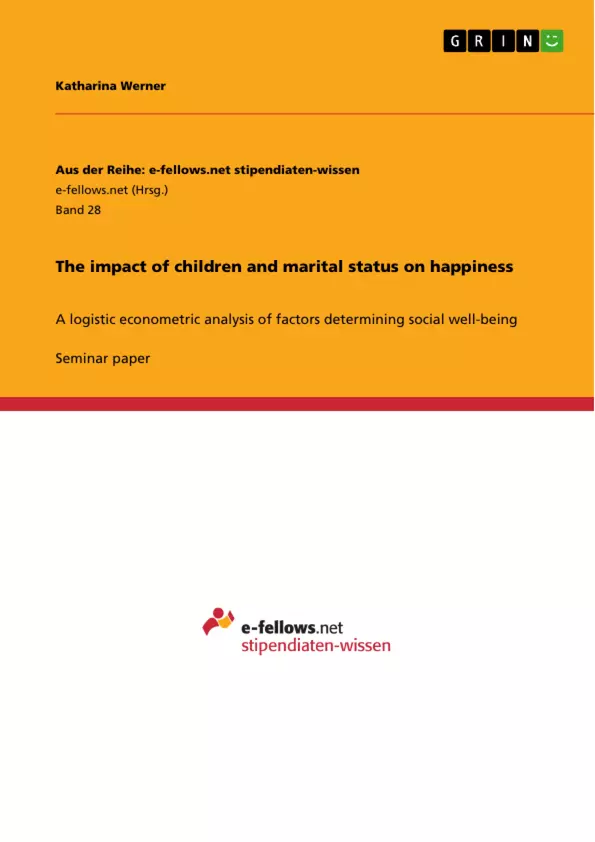- Determining factors influencing happiness and well-being becomes increasingly important as politics solely based on the maximization of income/GDP miss the goal of
increasing well-being.
- This study utilizes data from the 2008 wave of the General Social Survey - a survey comprised of demographic, behavioral, and attitudinal questions – to determine factors
that influence the probability of being happy.
- As expected, positive general factors are marriage, a high education and the per capita family income. However, only marriage has a high statistical significance.
- Negative determinants are unemployment, the number of hours worked per week, a
decrease in the family income and a perceived low relative income (compared to others).
- Being a parent, i.e. having at least one child has a negative effect. However, happiness is increasing with a rising number of children. It is important to note that the effects of
having children are very different among different groups of people: Children have a strong positive effect on married individuals and a low effect on divorced/separated and widowed ones. Being at least 21 years old when the first child is born increases the likelihood that children have a positive impact on happiness. Surprisingly, the effect of
children is positive if the children do not live with their parents or if the parents work a lot.
- Social comparison and adaption effects seem to play an important role.
Inhaltsverzeichnis (Table of Contents)
- Executive summary
- Introduction
- Motivation
- Defining Happiness
- Current research on happiness - a literature review
- Major determinants of happiness
- Income
- Marital status
- Children
- Data and Methods
- Results
- Interpretation of the basic model
- The impact of family issues
- Goodness of fit
- Conclusion
- Bibliography
Zielsetzung und Themenschwerpunkte (Objectives and Key Themes)
This study investigates the impact of family factors, specifically marital status and the presence of children, on individual happiness and well-being. It aims to contribute to the understanding of how these factors influence subjective well-being, going beyond traditional economic models that focus solely on income and GDP. This research uses data from the General Social Survey to explore the relationship between family life and happiness, taking into account various demographic, behavioral, and attitudinal variables.
- The relationship between family factors and happiness
- The importance of subjective well-being in economic and social policy
- The influence of income, education, and marital status on happiness
- The impact of children on happiness and how it varies across different groups
- The role of social comparison and adaptation in determining happiness
Zusammenfassung der Kapitel (Chapter Summaries)
- Executive Summary: The study analyzes factors influencing happiness, highlighting marriage, education, and family income as positive determinants, while unemployment, work hours, income decline, and relative income contribute negatively. The presence of children has a negative impact overall, though the effect is positive for married individuals and those who had their first child at age 21 or older. Notably, children having a positive impact is also observed when they do not live with their parents or if the parents work extensively.
- Introduction: The study argues that traditional economic models based solely on income and GDP are inadequate for understanding well-being. The focus is on shifting the focus to include factors like family life and happiness, acknowledging the limitations of GDP-centric policies. The motivation behind the research is to understand the impact of marriage and children on individual happiness and explore how policy can support families.
- Current Research on Happiness - A Literature Review: This chapter discusses the definition of happiness as a subjective perception and explores the key determinants of happiness as identified by previous research. This includes factors like income, marital status, and children, highlighting the complexity and nuances of their impact on well-being.
Schlüsselwörter (Keywords)
This study focuses on the relationship between family structure, specifically marriage and children, and individual happiness. Key concepts explored include subjective well-being, social comparison, adaptation effects, income, education, and the limitations of traditional economic models based on GDP maximization. The research draws on data from the General Social Survey to analyze these factors and their impact on life satisfaction.
- Citar trabajo
- Katharina Werner (Autor), 2011, The impact of children and marital status on happiness , Múnich, GRIN Verlag, https://www.grin.com/document/174226



